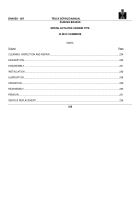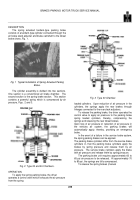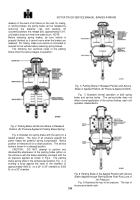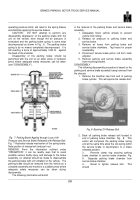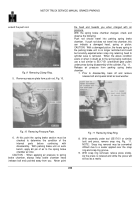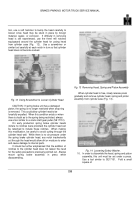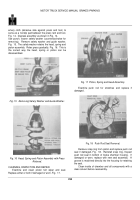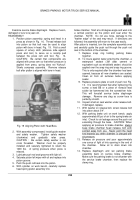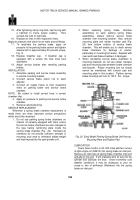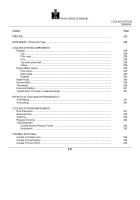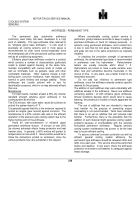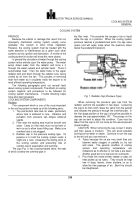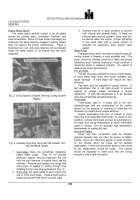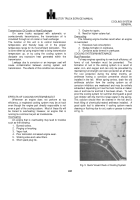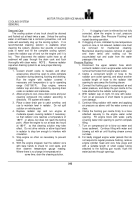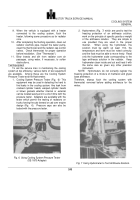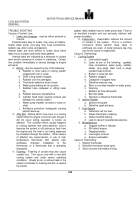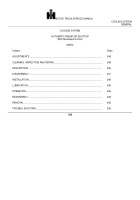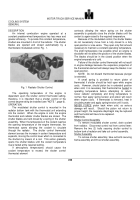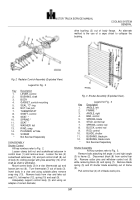TM-5-3805-254-14-P-2 - Page 242 of 894
MOTOR TRUCK SERVICE MANUAL
COOLING SYSTEM
GENERAL
ANTIFREEZE - PERMANENT TYPE
The
permanent
type
automotive
antifreeze
commonly used today has been developed to a high
point of reliability.
This type antifreeze often referred to
as "ethylene glycol base antifreeze, " is now used in
practically all cooling systems and in most cases is
recommended for year round service-especially since
the widespread use of the pressurized cooling system as
well as air conditioning equipment.
Ethylene glycol base antifreeze coolant is a product
which contains a number of characteristics particularly
suited to protect against freezing, at the same time,
maintain compatibility with various kinds of metals as
well as nonmetals such as gaskets, seals and other
nonmetallic materials.
Other features include a high
boiling point, corrosion resistance, foam resistant, non-
harmful to paint finishes and storage stability.
These
antifreezes are usually colored with a dye for
identification purposes, which in no way adversely affects
their use.
Maintenance
For best results, maintain at least a 33% (by volume)
standard strength ethylene glycol antifreeze in the
cooling system at all times.
The 33% mixture, with clean water, would be sufficient to
protect the system down to 0* F.
It is generally agreed that this is the minimum required to
protect an engine (year around) against corrosion.
The
maintenance of a 33% solution also aids in the efficient
operation of the pressure type cooling system due to the
higher boiling point of the antifreeze.
Avoid an over-concentration of ethylene glycol
permanent antifreeze mixture.
A mixture of over 60%
(by volume) adversely affects freeze protection and heat
transfer rates.
In general, a 60% mixture will protect to
temperatures as low as 60 F.
Good practice would be to
follow the instructions printed on containers, since the
various products may vary somewhat in this respect.
Where considerable cooling system service is
performed, good procedure would be to keep a supply of
premixed antifreeze on hand for makeup purposes.
In
systems using permanent antifreeze, most coolant loss
is due to over-flow-not boil away; therefore, antifreeze
and water are lost in the same proportions as originally
installed.
In checking the protective strength of permanent
antifreeze, the refractometer type tester is recommended
in preference over the hydrometer.
Refractometer
testers are usually accurate within about 1 F.
Hydrometers are known to have a wide variation even
when new and sometimes become inaccurate in the
course of time.
In any event, use a tester known to be
reasonably accurate.
Do not add rust inhibitors to permanent type
anitfreeze, since the antifreeze already contains specific
material for this purpose.
The addition of such additives may react undesirably with
additives already in the antifreeze.
Never use additives
containing soluble / oil with ethylene glycol antifreeze.
Should conditions develop which would tend to cause
foaming, the presence of soluble oil would aggravate the
foaming.
The use of additives that are intended to improve
heat transfer for the purpose of preventing engine
overheating is not recommended.
Tests have indicated
that there is as yet no additive that will increase heat
transfer.
Furthermore, there is the possibility that the
addition of such material might generate cooling system
problems because of incompatibility with the carefully
formulated permanent antifreeze.
Regular periodic
cooling system maintenance has proven to be the best
way to insure efficient cooling.
To assure continued corrosion protection as well as
efficient
general
cooling
system
efficiency,
the
permanent type antifreeze should be renewed (drain and
refill) once each year.
This service should be performed
before cold weather.
In any event, check the antifreeze
protection level before cold weather to safeguard against
freeze damage.
238
Back to Top

